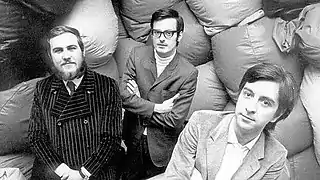Bean bag chair
The Sacco chair, also called bean bag chair, is a large fabric bag, filled with polystyrene beans, designed by Piero Gatti, Cesare Paolini and Franco Teodoro. The product is an example of an anatomic chair,[1] as the shape of the object is set by the user.
 | |
| Designer | Piero Gatti, Cesare Paolini, Franco Teodoro |
|---|---|
| Date | 1968 |
| Style / tradition | Radical design |
| Collection | MOMA · Museum of Modern Art, New York and 25 other contemporary art museums throughout the world. In 2020 Sacco was awarded the XXVI Premio Compasso d'Oro. |
History
Sacco was introduced in 1968 by three Italian designers: Piero Gatti, Cesare Paolini and Franco Teodoro.[1] The object was created in the Italian Modernism movement.[2] Being a post war era phenomenon, Italian modernism’s design was highly inspired with new available technology. Post war technology allowed an increase in the processes of production, by introducing new materials such as polystyrene. The idea of mass-produced goods made within an inexpensive price range appealed to consumers. It therefore created the need for a revolution in the creative and manufacturing process. ‘The designer was an integral member of a process that included marketing as well as engineering’. The inspiration left by Corradino D’Ascano’s Vespa design for the Piaggio Corporation in 1946, added value to the essence of the designer. With successful designs, brands could sell more products, and therefore the identity of the designer played an important advertising role. Another important figure of the Italian modernism period was Gio Ponti. Inspired by modernism's art movements, Ponti created new forms of objects. His asymmetrically balanced designs freed the Italian objects form their classic representations. The designer promoted Italian designs on famous exhibitions called 'Milan Triennale': "These exhibitions, organized as early as the 1920s … were responsible for increasing the visibility of Italian design in an international setting". After becoming an editor of the Domus (magazine) in 1947, Ponti contributed to not only Italian design of that time, but also : “the human and creative element in modern industrial design as well as its practical, economic and social benefits."[3]

Piero Gatti, Cesare Paolini and Franco Teodoro, inspired by their designer predecessors, came up in 1968 with the design of Sacco the ‘shapeless chair’.[4] Although it was not the first design of an amorphous chair in Italian history, Sacco was the first successful product created in partnership with Zanotta. The predecessor of the product had a major design flaw of not being able to sustain its form and therefore never reached production. Sacco picked up that flaw and with the use of leather for exterior and right placed stitching. It is worth mentioning that the use of leather was not coincidental as at that time the textile was an Italian national pride product.[3] The target user of the chair was the lax, hippie community and their non-conformist household. "In an era characterized by the hippie culture, apartment sharing and student demonstrations, the thirty-something designers created a nonpoltrona (non-chair) and thus launched an attack on good bourgeois taste."[1]
Sacco is part of the permanent collection of the most important museums of contemporary art throughout the world, such as the Museum of Modern Art in New York, the Centre Pompidou in Paris and the Victoria and Albert Museum in London. Sacco was part of the 1972 exhibition at the Museum of Modern Art in New York Italy: The New Domestic Landscape - Achievements and Problems of Italian Design[5] and was awarded, in 1973, the BIO 5 at the Biennale of Design in Ljubljana. In 2020 Sacco received the prestigious Compasso d'Oro Award.[6]
Piero Gatti, Cesare Paolini and Franco Teodoro established their architecture firm in Turin in 1965.[7]
Exhibitions
Museum of Modern Art, New York: Recent Acquisitions: Design Collection, 1 December 1970, 31 January 1971
Museum of Modern Art, New York: Italy: The New Domestic Landscape, 26 May - 11 September 1972
Solomon R. Guggenheim Museum, The Italian Metamorphosis,1943-1968, 7 October 1994—22 January 1995 [Triennale di Milano February—May 1995, Kunstmuseum Wolfsburg May—September 1995]
Museum of Modern Art, New York: Architecture and Design: Inaugural Installation, 20 November 2004 - 7 November 2005
Cité de l’Architecture et du Patrimoine, Paris: Architects’ Furniture: 1960–2020, September 2019
Collections
Museum of Modern Art, New York
Israel Museum, Jerusalem
Uměleckoprůmyslové Muzeum, Prague
Kunstgewerbemuseum, Berlin
Victoria and Albert Museum, London
Kunstmuseum, Düsseldorf
Museum für angewandte Kunst, Vienna
Taideteollisuusmuseo Konstindustrimuseet, Helsinki
Musée des Arts Décoratifs, Paris
The Saint Louis Art Museum, Saint Louis
Museo dell'arredo contemporaneo, Russi (Ra)
Museum für Kunst und Gewerbe, Hamburg
Denver Art Museum, Denver
Dallas Museum of Art, Dallas
Fondazione Triennale Design Museum, Milan
Tel Aviv Museum of Art, Tel Aviv
Vitra Design Museum, Weil am Rhein
Musée National d'Art Moderne (Centre Pompidou), Paris
Thessaloniki Design Museum, Thessaloniki
Brücke-Museum, Berlin
Fonds Régional d'Art Contemporain, Dunkerque
Centro Arte e Design, Calenzano
Museum of Applied Arts and Sciences, Powerhouse Museum, Sydney
Museum voor Sierkunst en Vormgeving, Gent
Philadelphia Museum of Art, Philadelphia
Shiodome Italia Creative Center, Tokyo
Awards
Bio 5 Ljubljana, Biennale of Design Ljubljana, 1973
Selected for the Compasso d'Oro Award, 1970
M.I.A.- Mostra Internazionale dell'Arredamento, Monza, 1968
XXVI Compasso d'Oro Award, 2020
Sacco in the media
Sacco often appears in the strips Peanuts by Charles M. Schulz.
Other bean bag chair products inspired by Sacco
Other designers have followed the "shapeless" chair design, creating a range of inspired products that take after Sacco.[8] Amongst many, the most successful contemporary model would be Jukka Setala’s Fatboy. The product launched in 2002 brought the Finnish designer global recognition. The new form of the bean bag chair has less stitching and a more geometrical take in the means of shape. It also has an EPS filling which is more durable than PVC.[9]
Bibliography
- Paola Antonelli (Museum of Modern Art | MOMA), Sacco Chair | Object Lesson
- Mel Byars, The Design Encyclopedia, New York, John Wiley & Sons, Inc., 1994
- Emilio Ambasz [a cura di], Italy: The New Domestic Landscape - Achievements and Problems of Italian Design, New York, Museum Of Modern Art, 1972
- Grace Lees-Maffei, Kjetil Fallan [editors], Made in Italy Rethinking a Century of Italian Design, London, Bloomsbury Academic, 2014
- Bernhard E. Bürdek, Design Storia, Teoria e Pratica del Design del Prodotto, Roma, Gangemi Editore, 2008
- Modern Chairs 1918-1970, London: Lund Humphries. 1971
- Victor Papanek, Design for the Real World, New York: 1974
- Moderne Klassiker, Mobel, die Geschichte machen, Hamburg, 1982
- Kathryn B. Hiesinger and George H. Marcus III (eds.), Design Since 1945, Philadelphia, Philadelphia Museum of Art, 1983
- Fifty Chairs that Changed the World: Design Museum Fifty, London's Design Museum, London, ISBN 978-1840915402
- Charlotte Fiell, Peter Fiell, Plastic dreams: synthetic visions in design, Carlton Books Ltd, 2010, ISBN 978-1906863081
- Anne Bony, Design: History, Main Trends, Major Figures, Larousse/Chambers, 2005
- Bernd Polster, Claudia Newman, Markus Schuler, The A-Z of Modern Design, Merrell Publishers Ltd, 2009, ISBN 978-1858945026
- Domitilla Dardi, Il design in cento oggetti, Federico Motta Editore, Milano, 2008, ISBN 978-88-7179-586-7
- Anty Pansera, Il Design del mobile italiano dal 1946 a oggi, Laterza, 1990
- Charles Boyce, Joseph T. Butler, Dictionary of Furniture, Simon and Schuster, New York, 2014, ISBN 9781628738407
- Michael Tambini, The Look of the Century, DK Pub., 1999, ISBN 9780789446350
- AA.VV., 100 objects of italian design La Triennale di Milano: Permanent Collection of Italian Design, The Milan Triennale, Gangemi Editore
- Germano Celant [ed.], preface by Umberto Eco,The Italian Metamorphosis, 1943–1968, Guggenheim Museum Publications, New York, 1994, ISBN 0-8109-6871-1
- Cindi Strauss, Germano Celant, J. Taylor Kubala, Radical - Italian Design 1965-1985 - The Dennis Freedman Collection, Yale University Press, 2020
References
- Vitra Design Museum. "Sacco". Retrieved 25 September 2014.
- MOMA, Museum of Modern Art, New York. "Object lesson: Paola Antonelli". Museum of Modern Art, New York. Retrieved 2020-11-17.
- Raizman, David (2010). "Part V: Humanism and Luxury: International Modernism and Mass Culture after World War II (1945-1960)". In May, Susie (ed.). History of Modern Design Second Edition. Laurence King Publishing. pp. 256–306. ISBN 978-1-85669-694-4.
- "'Sacco' beanbag designed by Piero Gatti, Cesare Paolini and Franco Teodoro". Museum of Applied Arts & Sciences, Australia.
- "Italy: The New Domestic Landscape". MOMA, Museum of Modern Art, New York. Retrieved 2020-11-17.
- "The winners of the 2020 Compasso d'Oro Awards". Domus. Retrieved 2020-11-17.
- ""'Sacco' beanbag designed by Piero Gatti, Cesare Paolini and Franco Teodoro"". Museum of Applied Arts & Sciences, Australia.
- Griffiths, Sally (2 June 2009). "How to bag a beanbag chair". The Guardian. Retrieved 10 January 2014.
- Fatboy (2002). "Fatboy original". Fatboy. Archived from the original on 2017-09-10. Retrieved 16 October 2014.
External links
- Museum of Modern Art, New York
- Victoria & Albert Museum, London
- Centre Pompidou, Paris
- Vitra Design Museum
- Museum of Applied Arts & Sciences, Sidney
- Paola Antonelli (Museum of Modern Art, New York), Sacco Chair | Object Lesson
- Italy: The New Domestic Landscape, Museum Of Modern Art, New York
- The Italian Metamorphosis,1943-1968, Solomon R. Guggenheim Museum, New York
- Cesare Paolini [architect], Museum Of Modern Art, New York | Centre Pompidou
- Franco Teodoro, Museum Of Modern Art, New York
- Piero Gatti, Museum Of Modern Art, New York